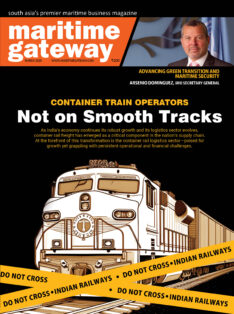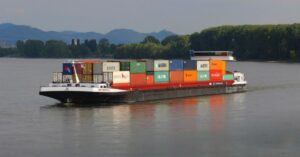You are on a lot of these logistics committees of the trade associations and you also have huge experience behind you in shipping and logistics. So, tell us how is the CFS business in India because recently we have discussed the sustainability model for the container freight stations? Right now, I understand CFSs are facing lot of challenges apart from the trade being impacted by scenarios like Covid, a lot of regulatory changes are coming. The competition is stiff. So, in this background, how is the CFS business?
Let me give you a small background. CFS business original model was different. I mean it was just cash and carry business sort of thing. Now, the challenges are actually coming in. So, it will be the survival of the fittest, I will use this word. The fact is the CFS business has been very good. We had continuous growth and we were market leaders continuously. Today also, despite the government’s regulation of DPD, still we are maintaining the largest volume. The CFS in the East are basically dependent only on import volumes. Because the policy is not designed in such a way as it is in the national forum in the country-wise that the policy is meant for both import and export, so the CFS here are mainly dependent on import. Only 10% to 12% of the exports are routed through CFS. So, importers in general, I’m myself a large importer and exporter. Importers in the East and across the country are concerned about only one thing – the logistics cost. So, whosoever gives the lowest cost, the box goes to him. So, as a CFS operator when we have a land bank of 1,25000 square meters, largest piece of parcel which we own, so now the point is how do we actually utilize these 1,25000 square meters? This can be utilized in two ways – by encouraging exports, making people understand why should you use CFS, how cost-effective we can make it, what is the value addition we can give to the customer? Even, we have approached customers and told them that we will take care of your goods once it is ready to be out from your factory. We will take care of its packing, labelling, movement, stuffing, lashing, choking and see that it is loaded on-time onto the vessel and even to the extent, if required, we hand over the bill of lading to them. You see this type of value-addition services when we have started, we have found that there has been a huge response from the export community. On the imports front government is mainly focusing on DPD. Although in my last seminar, I had raised this issue. We don’t have a uniform policy for imports. Across the country, it is 48 hours but in some ports, it is 96 hours, some ports it is 7 days; that uniformity has to be there. Otherwise CFS business is not a bad business and if you add value to it, if you give end-to-end solution to a customer, bring more value and confidence to the customer, you will sustain.
You mentioned one important point that customers want only reduction in logistics cost. One way is encouraging them to make the full utilization of the container freight station by getting into exports. But, logistics cost reduction is not only from the customer’s side, but government also through its Logistics Department has been focusing on reducing the logistics cost. So, what are the other suggestions or key policy-related issues that can be tweaked to bring down the logistics cost?
Logistics cost in the country is contributing to almost 40% in transportation. So, transportation in this country according to me, and you are more exposed to it, you will know that it is the most unorganized sector in this country where we do not have a policy. We do not have a policy of any framework on road transportation as far as I am aware of it. We do not have a load restriction. You see, now when we are exporting goods from here to Japan and US, I am very aware that my container should not have more than 18 tonnes, but when the same shipment is coming from US to India, it is coming 26 tonnes, so why is our country accepting that. Once we have a control on the rate load and ensure that beyond 18 tonnes it will be heavily taxed, then automatically this will get controlled. On the other hand, what will happen? Today, 26 tonnes is coming and there is no restriction, tomorrow when 18 tonnes is coming, there will be a 30% surge, 40% surge in the traffic. Why the government is not understanding this simple view, and imposing this weight restriction into the country? See, the point is wherever government has become strict, laws and systems have been in place. Wherever they have given freedom, it has been misused.
You mentioned about value-added services. So, what exactly you have in mind when you say value-added services, and CFSs also can look at other areas of cargo handling?
Value-added services means as we have always been telling that port should always use the port area only for receiving and supplying containers onto the vessel. Similarly, manufacturers should concentrate only on the manufacturing of the goods and they should leave all other activities to reliable, dependable and committed logistics suppliers like marking, packing, palletisation, labelling, bar coding, all these things can be left onto the logistics. So, if they spend more of their time into manufacturing, then manufacturing will go up. They think by doing these activities, they will be reducing cost, but actually they will be wasting time which is a cost not accounted for. So, whenever I meet an exporter, I tell them the only best thing for you is to concentrate on your product and your manufacturing and leave rest on others. We have actually converted many exporters from putting their head into all these small things and come to us. We reduced their cost, gave value to them and the best part is that they have not received any complaint from their end customer. So, this is how the word of mouth will spread. Second is today, because CFSs are underutilized, I think there is a huge scope where the CFS can be utilized by denotifying certain area and handling domestic cargo. With Atmanirbhar Bharat coming into picture, I think there is a huge scope for warehousing manufacturing, by handling domestic cargo, they can keep themselves floating, sustainable, bring more value addition and profitability to the business.
Let us talk about your region, especially in the eastern region, where you have your business and also you are representing the trade association in that region. How are things at Kolkata Port and in general the trade scenario in Eastern region?
Eastern region, especially Northeast is the focus of the country today. Because the growth was very slow and the scope was initially not very visible, but with the government’s policy coming into picture, with lot of changes happening, I see that there is a huge scope of growth in the East as well as the Northeast where the focus was originally not there. You see, lot of SOPs have been given to Northeast manufacturing. In the east, because we have the port, airport, we have the entire gateway to the east and you know Thailand, Malaysia, Singapore, Myanmar, all these countries actually have a lot of potential to bring cargo into Kolkata. Recently, lot of Indian manufacturers have shifted their base to Bangladesh for manufacturing, and starting with one unit people have expanded into multiple units. Why? Because there is a scope of manufacturing there. From there they are getting the cargo back into Kolkata and then distributing. So, keeping all these things in mind, there is a huge scope for warehousing, committed transportation, and third thing is the cost of inefficiency which people used to pay in the East is reducing drastically. The cost of inefficiency in the logistics according to my data is more than 15% to 20% of the logistics cost which people never used to account for. They used to take it for granted. Now people have realized that this cost can be reduced with technology, efficient people, training, assurance and proper infrastructure in place. If this cost is brought down, it can be brought down to less than 3% also. Today, it is around 20%. So, that itself will be a huge factor of motivation to investors.
The government of West Bengal has announced EoI for Tajpur Port. What are your comments on that? Does it has any good business prospects?
Tajpur has a potential because there is a deep draft of 18 meters but unfortunately the backend area is not available. Unless and until some port which has an 18 meters draft possibility and does not has space, how can it grow? And today, acquiring space is a big problem. I don’t need to elaborate on it, that is a huge huge problem. If that is taken positively through government policies, then there is a possibility of Tajpur Port coming into very prominent situation. But apart from Tajpur, I will tell you, Kirtania, you must be aware of it. Kirtania is also a potential area, potential port with good draft, so that also has a possibility. So, if Kirtania comes up and Tajpur doesn’t come, then Kolkata Port will have a tough time I think so.
As Century Group, what are your plans in this shipping and logistics business. Beyond Kolkata region, are you looking at expanding your CFS operations or getting into any other related businesses?
In fact, we have put up an EoI for Kolkata Port KPD west, where 600 bidders have also shown interest. That is sort of a backward integration to our logistics. In fact, we had a very large plan of spending about Rs.700 crores and expansion to be done into the CFS and ICD business across the country, but because of that DPD and DPE policy, we do not see immediate positive response because it is now a competition between a port and the CFS. Earlier, we were acting as a facilitator to the port. Now, the port and CFSs have become competitors. So, in that situation, it is really difficult to expand into CFS business but surely I will say that we are working very closely with various agencies to enter into logistics in a big way apart from the CFS what we are having, and that will take into account maybe specialized vehicles, warehousing, normally across the country if you see, 85% to 90% of the warehouses are actually godowns. But we will go for automated warehousing which actually people are looking for but people are not willing to spend that much of money because they think that possibly the rent will be like that and all those things but our technology and modus operandi and thought process of implementation will be totally different. So that is an area where we are thinking on. Then we have plans to connect East and Northeast, because we see a lot of future in that so we are planning to put up lot of money into the Northeast, we have a lot of investment in the Northeast and East, and simultaneously give a hub and spoke arrangement to the trade whereby the trade should not be bothered about unavailability of trucks. We will take total responsibility and people have trust and faith in our brand.
Covid-19 pandemic has affected every business. So, how did it impact your business and what are the lessons you have learnt from this pandemic?
Covid-19 has not impacted any business according to me, at least not to us. What has impacted is the government’s policy which was more than Covid-19. In fact, as a group we have surpassed all limits of 34 years during this Covid-19 period. So, we have done exceedingly well and not only in CFS business but in other parent businesses also, we have done exceedingly well. So, what we learnt from Covid-19 is you should know how to extract the best from the crisis, learn the best from it, learn to overcome crisis, encourage, motivate, provoke people during crisis, so that they can efficiently enhance their capacities and double their capacities. During the Covid, our working strength may be less, but potentiality of that strength was almost two-and-a-half times, because they were freely working, they were open to all ideas, they were having all accesses possible given to them. So, Covid-19 has not actually given us any retardation, in fact it has given acceleration to us.











